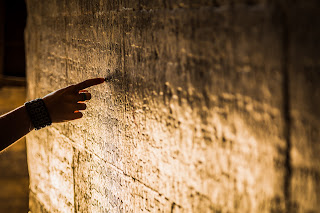Uncovering the Language of Yoga: The Secrets of Sanskrit
Uncovering the Language of Yoga: The Secrets of Sanskrit
If you've been to a yoga class before, you've likely heard some strange words said or chanted by the teacher in a foreign language you might not have been able to identify; this is Sanskrit. The Sanskrit language is integral to yoga because it allows you to delve deeper into this practice's philosophical meaning and vibrational sounds.
Like many other ancient languages, Sanskrit is profoundly complex and intertwined with India's philosophy and spiritual practices. Sanskrit was the language used by the sages of India to explain profound philosophies. Often these insights were condensed into short phrases and strands of words with deep meaning hidden in each letter and word. The uniqueness of the Sanskrit language lies in the depth of a single word and the power of the sounds each tone creates. Chanting in Sanskrit can allow you to access these hidden vibrational sounds and tune into the energy of the elements and the universe itself. Each word in Sanskrit carries not only the power of its meaning but also the power of the vibrations it creates when vocalized.
The uniqueness of the Sanskrit language lies in the depth of a single word and the power of the sounds each tone creates. Chanting in Sanskrit can allow you to access these hidden vibrational sounds and tune into the energy of the elements and the universe itself. Each word in Sanskrit carries not only the power of its meaning but also the power of the vibrations it creates when vocalized.
The Roots of the Sanskrit Language
The Important Connection Between Sanskrit and Yoga
The Key to Pronouncing Sanskrit Words
Unlike other languages where each letter may be pronounced differently depending on its location in a word or adjoining letters (or even by seemingly arbitrary rules of pronunciation), Sanskrit letters are always pronounced the same.
Each letter in the Sanskrit alphabet has a single pronunciation. So, when you learn to read Sanskrit words either in the original Devanagari script or when they are correctly transliterated, you can genuinely pronounce each word correctly. Sanskrit letters are organized in the alphabet by the shape the mouth creates to make the sound. For example, the guttural consonants of k, kh, g, gh, and ṅ are pronounced in the back of the throat. The Sanskrit alphabet is organized in this way to make it easier to sound out each letter and understand the alphabet phonetically.
Commonly Used Sanskrit Words in Yoga
15 Sanskrit Root Words in Yoga Poses:
5. Adho (ah-doh) – down
This root word can be found in the famous pose Adho Mukha Svanasana or Downward Facing Dog Pose.
6. Utthita (uht-heet-ah) – extended
Another root found in many yoga poses, one of the most famous is Utthita Hasta Padangusthasana, or Extended Hand to Big Toe Pose.
7. Hasta (ha-st-ha) – hand
Combined with the earlier root word pada, these two roots form the yoga pose name Padahastasana or Hand to Foot Forward Bend Pose.
8. Pārśva (paar-shva) – sides
Many yoga poses incorporate this root word, typically when you are turning to one side. One example is Parva Balasana or Thread the Needle Pose.
9. Kōṇa (koh-naa) – angle, corner
Combining the above root words utthita and parsva, you will get the wonderful yoga pose Utthita Parsvakonasana or Extended Side Angle Pose.
10. Daṇḍa (dan-da) – rod, staff, stick
This root word forms the basis of the foundational seated pose Dandasana or Staff Pose.
11. Sukha (suh-kha) – pleasure, happiness, joy, satisfaction, peace, in a state of comfort, ease
Sukha is a word commonly used in yoga philosophy to describe the opposite of pain or suffering (duhkha). But you can also find this root word in the pose Sukhasana or Easy Pose, which is often used for meditation.
12. Ardha (ar-dha) – half
This root word is also sprinkled among many yoga pose names; Ardha Chandrasana or Half Moon Pose is one of the most popular.
13. Supta (soup-ta) – dreaming, asleep, sleeping, dormant
Found in the beloved yoga pose name Supta Baddha Konasana or Reclining Bound Angle Pose, this root word provides a deeper insight into the relaxed state this pose can provide.
14. Parivṛtta (pari-vri-tta) – turned back, revolved, turned around
This root word is used before many yoga pose names to refer to the revolved or reversed versions, such as Parivritta Trikonasana or Revolved Triangle Pose.
15. Ūrdhva (oor-dh-va) – upwards, upward facing
Another root word used before many yoga pose names, this root describes the upwards or exalted version, such as Urdhva Hastasana or Upward Salute.
4 Other Important Sanskrit Words in Yoga:
- Yama – moral disciplines / external disciplines
- Niyama – self-disciplines / internal disciplines
- Asana – postures
- Pranayama – breathing practices
- Pratyahara – restraint of mind or the senses
- Dharana – contemplation
- Dhyana – meditation
- Samadhi – completion, enlightenment, absorption
- Sattva – goodness, light, harmony, creation
- Rajas – passion, action, movement, preservation
- Tamas – darkness, stability, potential, destruction




Comments
Post a Comment